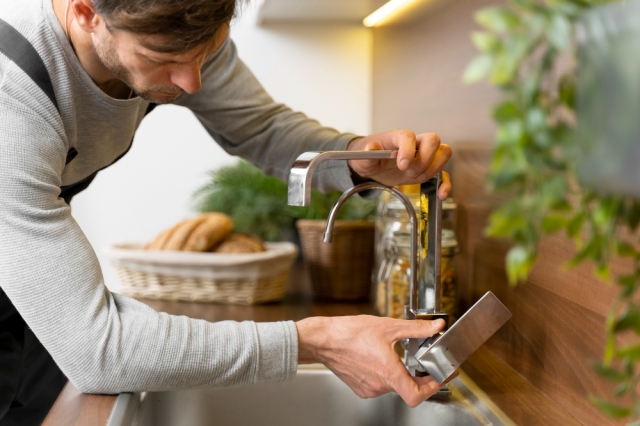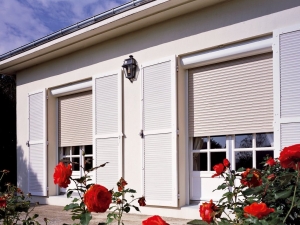Optimal water pressure in your home not only enhances your day-to-day experiences but also ensures a well-functioning plumbing system. Addressing fluctuations can significantly improve the quality of your life.
Fergusons Plumbing experts affirm that constant high pressure can lead to extensive damage, creating more issues than mere inconvenience. Hence, it's crucial to maintain a balance and prevent your pipes from needless strain.
Solving pressure problems starts from understanding its underlying causes. Don't endure low water pressure in silence - find effective solutions that make your household tasks smoother and faster.
Understanding Water Pressure
Water pressure is the force in your home's water system. A balanced pressure guarantees steady delivery of water in all outlets like taps and showers.
Factors Affecting Pressure
Certain elements directly influence your water pressure. These include the elevation level, plumbing conditions, and the water company's main supply pressure.
Your locality's height relative to your provider's reservoir can impact the water flow. The higher it is, the lower your pressure will likely be.
Ill-Equipped Plumbing
Poorly equipped or malfunctioning plumbing systems also degrade the water pressure. Older pipes with rust or sediment deposits obstruct the smooth flow of water.
Main Supply Pressure
The force at which your provider supplies you with water affects your home's pressure. It varies largely, depending on a provider's specifications.
If they deliver with low force, you may face issues even if your plumbing is perfect. Thus, knowing their standards helps assess your household needs.
Diagnosing Water Pressure Problems
Understanding the cause of low water pressure in your home is crucial. Numerous factors might contribute to this often frustrating issue.
Identify the Source
You should start by isolating the problem. Are you experiencing low water pressure in all outlets or just a single faucet?
If the problem is localized, it could be due to a restricted flow. Possibly, mineral deposits have accumulated in your faucets or showerheads.
Check Pressure Regulator
Another possible culprit is the home's pressure regulator. Not all residences have one, but if yours does, improper settings could lead to low pressure.
The control of the pressure regulator is typically a gold-colored bell with a threaded screw protruding from the top. You can adjust it with a wrench.
Inspect Plumbing System
If these aren't the issues, check your plumbing system. An aged and corroded pipes could result in decreased water pressure throughout your home.
If they are beyond repair, consider pipe replacement. Although costly initially, they will greatly enhance your home's overall water performance.
Troubleshooting High and Low Pressure
Dealing with water pressure issues can be a challenge. Regardless of whether it's high or low, it can significantly impact your daily activities.
Low water pressure means insufficient flow. This difficulty can originate from clogged pipes, a faulty pressure regulator, or issues in the main supply.
High water pressure, on the other hand, often said to be over 80 psi, can put undue stress on your pipes potentially causing leaks.
- Inspect Your Pressure Regulator : If this device fails, it could cause dramatic changes in water pressure.
- Check for Pipe Leaks: Hidden leaks can reduce overall water flow leading to low pressure.
- Analyze Main Supply: Sometimes the issue might not be in your home but in the main supply line.
- Contact Professionals: If all else fails, you can reach out to professional plumbers for help.
The aim is to make your home a comfortable sanctuary by achieving optimal water pressure. This makes cleanliness and hygiene tasks significantly easier and enjoyable.
Maintaining Pressure Reducing Valve (PRV)
The Pressure Reducing Valve (PRV) plays a vital role in managing your home's water pressure. When properly maintained, it significantly boosts your plumbing system's efficiency.
Over time, minerals can build-up in your PRV. This typically leads to inconsistent water pressure, but a thorough cleaning can easily rectify this issue.
Ensure regular inspection of your PRV. With age, wear and tear is unavoidable. Prompt repairs or replacements will prevent severe water pressure issues down the road.
- Regular Cleaning: Removing mineral accumulations prolongs the lifespan of your PRV and maintains optimal water pressure.
- Yearly Inspections: Regular checks help identify potential problems before they escalate into significant issues, reducing unexpected expenses.
- Prompt Repairs: Quick attention to faults minimizes downtime and ensures a steady water supply at all times.
A well-serviced PRV works smoothly, optimizing water flow in your home. Stick to these maintenance practices, and reap the benefits of better water pressure.
The importance of a fully functional PRV is undeniable. Strive for consistent care - it'll lead to a positive home experience with optimal water usage.
Handling Clogged Aerators
A common issue affecting water pressure is a clogged aerator. This part of your faucet can collect minerals and debris over time.
Identifying the Problem
You can start by checking the faucet for white build-up. This is usually the first signal that the aerator is hindering your water flow.
If ignored, it could lead to considerable pressure drop. Don't feel defeated, the solution is easier than you think.
Cleaning Aerators
Cleaning aerators regularly keeps your water pressure consistent. Start by unscrewing it from the faucet. Examine it for possible debris or mineral deposits.
A Simple Solution
You don't need a technical background to do this. Just soak the aerator in vinegar overnight. With a brush, scrub gently to remove residual particles.
Maintenance Matters
Regular maintenance is crucial. Cleaning every few months maintains optimal pressure and prolongs the life of your faucet. Get more insights on plumbing issues.
Solving water pressure issues doesn't always require professional intervention. With a few simple steps, you can enhance your home experience significantly.
Operating Main and Meter Valves
Your home's water pressure can have an impact on both comfort and utility costs. Knowing how to optimize it is key to a positive experience.
What is the role of the main valve?
The main valve controls the entire household water supply. If this isn't functioning properly, it can cause problems with your overall water pressure.
How does the meter valve affect water pressure?
Water supply and flow are linked to the meter valve. If it's not open completely, it can create a drop in pressure throughout your home.
Can these valves improve water pressure?
Yes, checking and adjusting these valves can aid in improving water pressure. It's essential to ensure their proper function for optimal performance.
What if adjusting valves doesn't help?
If adjusting valves does not improve the situation, it might be a larger problem within your plumbing system that needs professional attention.
Fixing Failing Pressure Regulators
Experiencing issues with water pressure often points to a faulty pressure regulator. Thankfully, you can manage such problems at home.
Your water pressure regulator controls the volume of water passing through your home's pipes. If it malfunctions, it impacts the overall water pressure.
- Identify the Issue: You should first check your regulator visually for any potential damage or leaks.
- Adjust the Valve: Using a wrench, try tightening or loosening the regulator's adjustment screw to alter the pressure.
- Change Filters: If your home has a filtration system, replacing clogged filters could solve the issue.
- Contact Professionals: If these steps do not work, consult with a professional plumber for further guidance and potential replacement.
A malfunctioning water pressure regulator could result from various factors like wear and tear or damage. Identifying such issues early prevents major disruptions to your daily tasks.
If you're interested in additional insights on dealing with pressure regulator problems, visit this detailed discussion thread on Reddit's Plumbing community.
Optimized water pressure enhances your home experience by ensuring smooth operation of appliances and preventing potential damage to your plumbing infrastructure.
Understanding these solutions empowers you to tackle issues head-on, without unnecessary stress or costly repairs. Knowledge is power - wield it effectively!
Faulty Plumbing Fixtures Repair
In your home, unpredictable water pressure could be the symptom of faulty plumbing fixtures. They can considerably disrupt your optimal water flow.
Common culprits might include old showerheads, corroded pipes, or failing valves. Unaddressed issues may lead to significant damage causing extensive and costly repair work.
|
Fixture |
Possible Problem |
Solution |
|
Showerhead |
Build-up of limescale |
Clean or replace |
|
Pipes |
Corrosion due to age |
Replacement |
|
Valves |
Failing parts or leaks |
Repair or replace |
|
Faucets |
Clogging |
Cleaning or replacement |
To maintain adequate water pressure, routinely check your home's plumbing fixtures for signs of wear and tear or other potential problems.
If troublesome issues are detected, promptly arrange expert attention. Adhere to a regular maintenance schedule to curb any complications.
This routine can enhance your overall home experience, by assuring you a steady and reliable water supply without any sudden and unwelcome discrepancies.
Dealing with Water Supply Issues
Experiencing low water pressure at home can be a nuisance. However, it's essential to identify the source of this issue for an effective solution.
Check Your Main Valve
The main water valve regulates the water entering your house. Ensure it is fully open to maximize your home's water pressure.
Analyze Individual Faucets
Sometimes, the problem might lie with individual faucets. Check each one for blockages or damage that could be reducing water flow.
Inspect Your Pipes
Pipe issues like corrosion or leakage can also cause low water pressure. Regular inspection and timely maintenance can help prevent these problems.
Contact a Professional
If all else fails, you might need to call a plumbing professional. They have the expertise to diagnose and resolve complex water pressure issues.
Unclogging and Maintaining Water Pipes
Struggling with low water pressure? It may be a sign of clogged pipes. Regular pipe maintenance can significantly improve your home's water pressure.
Potentially, debris and mineral deposits have accumulated inside your pipes over time. This reduces the overall capacity of the pipes, resulting in low water pressure.
- Close All Faucets: Ensure all faucets and outlets are closed to avoid water spills during the cleaning process.
- Determine The Clog Location: Identify if the clog affects all appliances or is isolated to a few. This will help you locate the problem area.
- Conduct Inspection: Visually inspect your pipes for visible blockages. In some cases, you might need a professional's help for this task.
- Clean Pipes Regularly: Periodic cleaning can prevent mineral build-up in your pipes. Consider using commercial cleaners or natural substances like vinegar and baking soda.
Incorporating these strategies into your pipe maintenance routine can lead to more consistent water pressure. Keep in mind; proactive action is key.
Don't forget; unclogging and maintaining water pipes not only boost water pressure but also enhances the water quality and overall functionality of plumbing systems.
Final Thoughts
You've gained an in-depth perspective on water pressure matters. Remember, for a seamless experience in your home and avoidance of future hassles, heed the warning signs, and optimize often. Need professional assistance? Visit Ferguson's Plumbing today.






